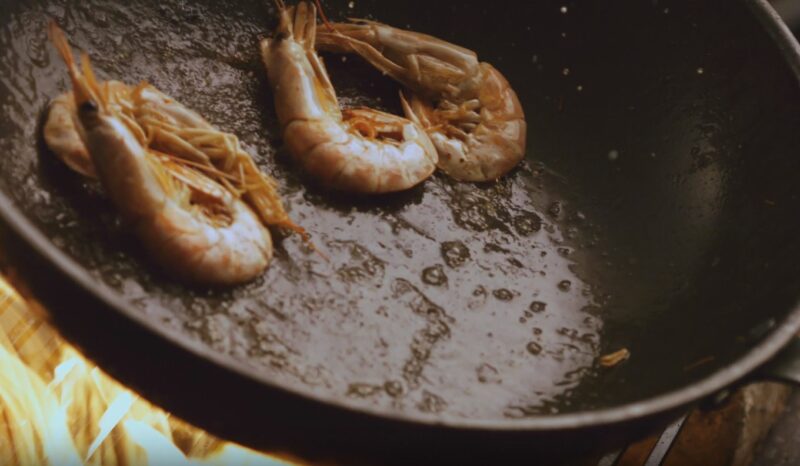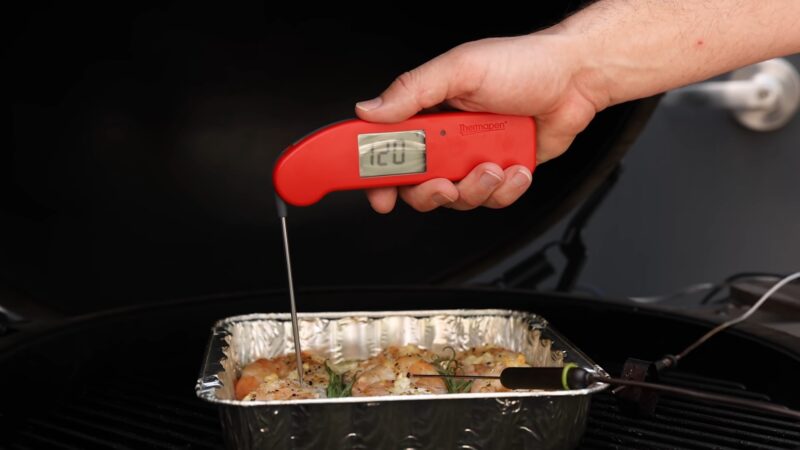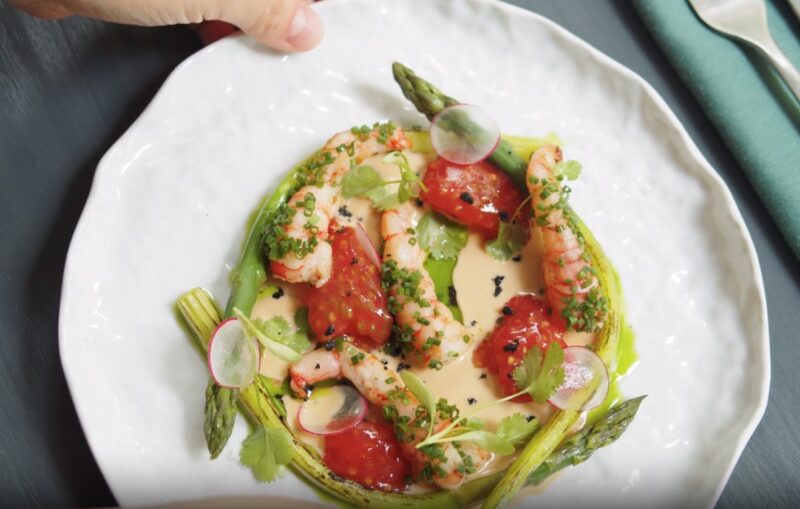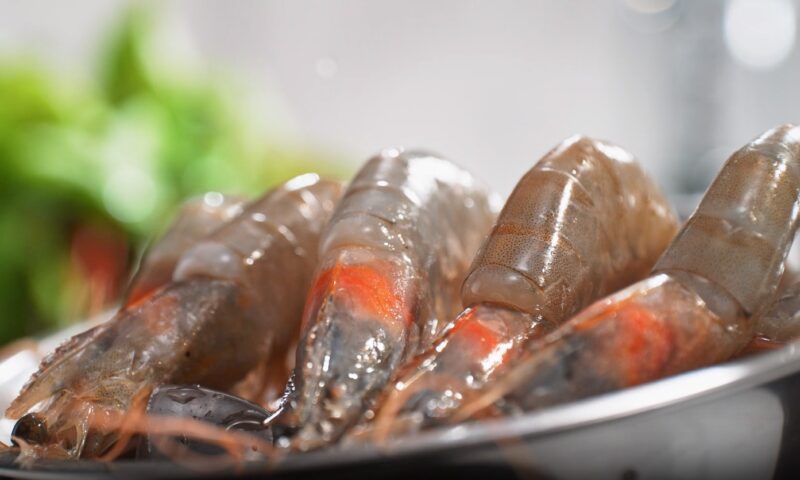There are many recipes that include raw fish and meat, with sushi begin the most popular. It is especially popular as part of Asian cuisine. However, not all seafood is edible as raw, which is the case with raw shrimp.
Why You Should Never Eat Raw Shrimp?

Foodborne illness is a significant risk with raw shrimp. Bacteria like Vibrio vulnificus, present in marine environments, can cause severe infections, leading to symptoms such as vomiting, diarrhea, and abdominal pain. In extreme cases, these infections can be fatal, especially in individuals with weakened immune systems.
The Risk of Toxins and Heavy Metals
Raw shrimp may also harbor toxins and heavy metals accumulated from polluted waters. These contaminants can have detrimental effects on health, including neurological damage and chronic diseases. The risks associated with these toxins are not worth the raw consumption of shrimp.
What are Potential Health issues and How to Deal with Them?
The consumption in raw state can lead to an array of health issues, primarily from bacterial infections and parasitic infestations. Symptoms may include nausea, vomiting, diarrhea, abdominal cramps, fever, and chills. Severe cases can result in dehydration, blood infections, and even long-term health problems if not addressed promptly.
Immediate Steps for Suspected Food Poisoning
If you suspect that you’ve contracted a foodborne illness, the first step is to stay hydrated and rest. Over-the-counter remedies may alleviate symptoms, but it’s crucial to seek medical attention if symptoms persist or worsen.
Health professionals can provide the necessary treatments, which may include antibiotics for bacterial infections or antiparasitic drugs for parasitic infections.
Long-Term Health Considerations
For those who have experienced food poisoning, the long-term focus should be on prevention. This includes being vigilant about the source of your seafood, avoiding raw dishes in favor of cooked options, and being mindful of any lingering effects that may warrant a doctor’s attention. For example, you might feel just fine for a day or two, and then the side-effects will start showing-off.
Preventative Measures in Food Preparation

Preventive measures are key to avoiding the health issues associated with raw shrimp. Always ensure that it is thoroughly cooked to the recommended internal temperature.
Purchase seafood from reputable suppliers, and adhere to strict food safety practices, including separating it from other foods, using clean utensils and surfaces, and washing hands frequently. These steps can significantly reduce the risk of foodborne illness.
Life-Threatening Risks
It can indeed become life-threatening, particularly due to the presence of harmful bacteria such as Vibrio, which can cause severe infections like septicemia. These infections are especially dangerous for individuals with compromised immune systems, liver disease, or other underlying health conditions.
Certain populations are more vulnerable to the dangers of consuming raw shrimp. This includes the elderly, pregnant women, young children, and those with chronic health conditions. In these groups, the body’s ability to fight off infections is often weaker, making them more susceptible to severe complications that can lead to hospitalization or, in extreme cases, death.
When to Seek Emergency Care?
It’s vital to recognize when symptoms go beyond the typical food poisoning scenario. Signs that warrant immediate medical attention include high fever, blood in stool, prolonged vomiting that prevents keeping liquids down, signs of dehydration such as dizziness and dry mouth, and any symptoms of allergic reaction. Quick response to these symptoms can be lifesaving.
How to Recognize It is Still Raw?
Recognizing that the meat is not prepared properly is essential for avoiding the risks associated with its consumption. The tell-tale signs of raw shrimp are its color and texture. In such state, it typically has a translucent appearance, whereas cooked shrimp becomes opaque and white with a pink or red tint.
Textural Indicators
The texture can also indicate its level of doneness. Raw shrimp tend to be more limp and soft. When properly cooked, shrimp should be firm to the touch and curl into a loose “C” shape. An undercooked shrimp may be partially transparent and less firm.
Temperature Check

If you’re cooking at home, using a food thermometer is the most reliable method to ensure shrimp is safe to eat. The internal temperature should reach 145 degrees Fahrenheit to be considered fully cooked.
When in Doubt
If you’re dining out and suspect that your dish may be undercooked, it’s important to trust your instincts. Don’t hesitate to send the dish back to the kitchen for further cooking. It’s better to be cautious than to risk the health complications that can arise from consuming raw shrimp.
Importance of Proper Handling
To reduce the risk of foodborne illness, proper handling is crucial. This includes purchasing shrimp from reputable sources, ensuring it is fresh or appropriately frozen, and maintaining clean preparation surfaces to avoid cross-contamination.
Cooking Recommendations

Cooking it thoroughly is the most effective way to eliminate harmful pathogens. The FDA recommends cooking shrimp to an internal temperature of 145 degrees Fahrenheit, at which point it should be opaque and pearly white.
Most Popular Recipes
Learning about safety guidelines is the only way to ensure that you will enjoy each time while having a lunch or a dinner that include shrimps. Here are the most popular recipes.
| Recipe Name | Ingredients | Preparation Instructions |
|---|---|---|
| Garlic Butter Shrimp |
|
|
| Shrimp Scampi |
|
|
| Classic Shrimp Boil |
|
|
Proper Cleaning Techniques
The process of cleaning is straightforward, yet crucial in preventing contamination and ensuring the safety of your dish. Begin by rinsing the shrimp in cold water to remove any loose sediment or debris. It’s recommended to do this even if the shrimp have been previously frozen.
Deveining
Deveining is an important step in cleaning. The vein, which is the digestive tract, can contain grit and is not pleasant to eat. To devein, make a shallow cut along the back of the shrimp and use the tip of your knife or a toothpick to lift out the vein. Rinse the shrimp again after deveining.
Removing the Shell
Depending on the recipe, you may need to remove the shell. To do this, hold onto the tail and peel the segments of the shell away. The tail can be left on for presentation purposes or removed if desired.
Final Check
After deveining and shelling, give the shrimp one final rinse in cold water. Check for any remaining shell fragments or veins. Once cleaned, pat the shrimp dry with paper towels before cooking.
Storage If Not Used Immediately
If you’re not planning to cook it right away, store them properly to maintain freshness. Place the cleaned shrimp in a sealed container or plastic bag with as much air removed as possible, and keep them in the coldest part of the refrigerator until you’re ready to use them.
Secure Only the Health Benefits
It is not only a versatile and delicious seafood but also a powerhouse of nutritional value. It is an excellent protein source that is low in calories and saturated fat, making it a favorable choice for a variety of diet plans. Additionally, it contains a wealth of vitamins and minerals that contribute to overall health.
| Nutrient | per 100 grams | % Daily Value (DV) |
|---|---|---|
| Calories | 99 kcal | 5% |
| Protein | 24 g | 48% |
| Total Fat | 0.3 g | <1% |
| Saturated Fat | 0.1 g | <1% |
| Cholesterol | 189 mg | 63% |
| Omega-3 fatty acids | 0.3 g | Varies |
| Sodium | 111 mg | 5% |
| Potassium | 259 mg | 7% |
| Calcium | 70 mg | 7% |
| Iron | 2.6 mg | 14% |
| Vitamin A | 60 IU | 1% |
| Vitamin C | 0 mg | 0% |
| Calcium | 50 mg | 5% |
| Iron | 0.4 mg | 2% |
FAQs
Can cooking methods other than heat, like marinating in citrus, make raw shrimp safe to eat?
Marinating shrimp in citrus juices, such as in ceviche, changes the texture of the shrimp but does not eliminate all harmful microorganisms. While it can reduce the risk of some pathogens, only proper heat treatment can ensure complete safety from bacteria and parasites.
Are certain types of shrimp safer to eat raw than others?
Sushi-grade shrimp is subjected to deep freezing that can kill parasites. However, this does not guarantee the elimination of all potential pathogens, especially bacteria. Consuming any raw shrimp carries risks, and cooking is the safest method to prevent foodborne illness.
Does the size of the shrimp affect the risk when eating it raw?
The size of the shrimp does not impact the risk of foodborne illness when consumed raw. The safety concerns with raw shrimp are related to pathogens, not the size of the shrimp.
If I’ve eaten raw shrimp before without getting sick, does that mean it’s safe?
Not necessarily. Previous safe experiences with eating raw shrimp do not guarantee future safety. Each instance of consuming raw shrimp carries its own risk, depending on the shrimp’s source, handling, and the individual’s immune system.
How can I tell if raw shrimp is contaminated?
There is no sure way to tell if raw shrimp is contaminated just by looking at it. Bacteria and parasites are microscopic and do not affect the appearance, smell, or taste of the shrimp. Laboratory testing is the only way to confirm the presence of pathogens.
Summary
While raw shrimp presents a myriad of concerns due to potential bacterial, parasitic, and chemical hazards, understanding the proper handling and preparation methods can mitigate these risks. Nutrient-rich and versatile, shrimp can be a healthy part of a diet when cooked properly or when alternative preparation methods are used cautiously.
